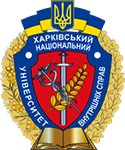Critical analysis of doctrinal approaches to the definition of “biological terrorism”
DOI:
https://doi.org/10.32631/v.2023.3.16Keywords:
terrorism, technological terrorism, pathogenic agents, biological weapons, biological warfare agents, biological disaster.Abstract
With the purpose of formulating a universal definition of the “biological terrorism” concept, the author clarifies the content and features of the generic concept of “terrorism”. In particular, the author examines the definitions of terrorism and its main features available in the scientific literature, as well as the approaches to the interpretation of its content used in national legislative and international legal acts. It has been argued that terrorism is not only criminal behaviour, but also a certain ideology which justifies the purpose of terrorist activity and the mechanisms for achieving it. On this basis, two doctrinal approaches to understanding terrorism, such as comprehensive and applied, have been identified. The article illustrates the use of the method of defining terrorism in international law by criminalising certain of its socially dangerous manifestations using specific examples. The main criminal features of terrorism have been identified. Terrorism has been defined as socially dangerous criminal acts provided for by international and national law, which consist of demonstrative public violence in a generally dangerous manner or with particular cruelty, as well as threats, organisation, preparation, logistical, financial and other support or incitement to commit such acts aimed at intimidating the population, inducing specific institutions or individuals to commit or refuse to commit certain acts, or with the aim of destabilising or destroying law and order.
National researchers’ approaches to the definition of “biological terrorism” have been analysed. It has been concluded that most of them have certain shortcomings, do not take into account doctrinal interpretations of terrorism and its features, and the peculiarities of pathogenic agents as a key component of biological weapons. The content of the legislative terms “technological terrorism” and “international terrorism” has been studied. Based on the results of the critical analysis and on the basis of the formulated definition of terrorism, it has been proposed to consider biological terrorism as a type of technological terrorism, and, if certain features are present, as international terrorism, and to understand it as socially dangerous culpable acts provided for by international and national legislation, which consist in demonstrative public use of biological weapons or their components (biological agents of biological destruction of biota), as well as threatening, organising, preparing, providing logistical, financial and other support or inciting to commit such actions aimed at intimidating the population, with the aim of inducing specific institutions or individuals to commit or refuse to commit certain actions, disrupting law and order or causing a biological disaster.
Downloads
References
Zelinskii, S. A. (1999). Political terrorism as a social and legal phenomenon. Current Problems of State and Law, 6(2), 40–46.
Antypenko, V. F. (2008). Optimizing the state’s anti-terrorist system in conditions of international and regional integration. International Relations Institute of NAU.
Semykin, M. V. (2004). Criminal liability for the creation of a terrorist group or terrorist organization [Candidate thesis, National University of Internal Affairs].
Leonov, B. D. (2016). Prevention of terrorism: criminological aspect. ArtEk.
Kubalskyi, V. N. (2007). Criminal and legal problems of combating terrorism in Ukraine [Candidate thesis, Institute of State and Law named after V. M. Koretskyi].
Zelenetskyi, V. S., Yemelianov, V. P., Nastiuk, V. Ya et al. (2008). Problems of systematization and comprehensive development of anti-terrorist legislation of Ukraine (V. S. Zelenetskyi & V. P Yemelianov, Eds). Right.
Husar, L. V. (2019). Problems of decision concept terrorism. Legal Position, 4(25), 151–157. https://doi.org/10.32836/2521-6473-2019-4-151-157.
Bantyshev, O. F., Zhuravlov, V. P., Kaliuzhnyi, R. A. et al. (2003). Terrorism: current state and international experience of struggle (Ya. Yu. Kondratiev & B. V. Romaniuk, Eds). National Academy of Internal Affairs.
Kurzova, V. V. (2013). Actual issues of legal regulation of international cooperation of Ukraine in the field of combating bioterrorism. Customs Business, 6(90), 34–43.
Holovatskyi, O. O. (2016). Bioterrorism: features and tactics of countermeasures. South Ukrainian Law Journal, 1, 18–20.
Kurtiak, B. M., Kovalenko, P. P., & Kabanets, S. I. (2015). Biological danger caused by the use of biopathogens for terrorist purposes. Communal Management of Cities, 120(1), 205–208.
Cherednychenko, K. Yu., & Hlynska, O. V. (2018). Biological terrorism as the most dangerous type of terrorist act (Art. 258 of the Criminal Code of Ukraine). Young Scientist, 10(62), 693–695.
Laputina, Yu. A. (2014). World experience of organization and legal provision of combating biological terrorism. Science and Practice, 1(12), 17–21.
Kvasiuk, V. V. (2018). Basic approaches to defining the concept of “bioterrorism”. Information and Law, 4(27), 121–125.
Shamsutdinov, O. V. (2022). Criminal law characteristics of mass destruction weapons as a criminal offense constructive objective feature (Articles 439, 440 of the Criminal Code of Ukraine). Law and Safety, 2(85), 189–201. https://doi.org/10.32631/pb.2022.2.18.
Salahor, I. M. (2017, May 23–24). Bioterrorism as one of the most dangerous crimes against biological security [Conference presentation abstract]. International Scientific and Practical Conference “Bioethics and Biosafety: Multidisciplinary Aspects”, Kharkiv, Ukraine.
Trebin, M. P. (2020). Biological terrorism: preparing the essence. The Bulletin of Yaroslav Mudryi National Law University. Series: Philosophy, Philosophy of Law, Political Science, Sociology, 2(45), 116–129. https://doi.org/10.21564/2075-7l90.45.200934.
Shamsutdinov, O. V., & Melnyk, D. S. (2022). Criminal law protection of critical infrastructure objects against subversive encroachments. Bulletin of Kharkiv National University of Internal Affairs, 3(98), 170–183. https://doi.org/10.32631/v.2022.3.16.
Korostylenko, V. A., Leonov, B. D., & Ryzhov, I. M. (2015). Terrorism: definition and essence (V. V. Krutov, I. I. Musiienko & V. P. Yemelianov, Eds.). National Academy of SSU.
Kravchuk, M. Yu. (2019). Formation of bioterrorism as a phenomenon of modern society. Entrepreneurship, Economy and Law, 9, 227-231. https://doi.org/10.32849/2663-5313/2019.9.38.



